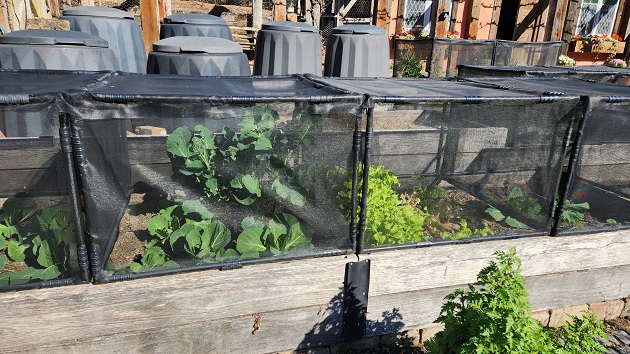The Benefits of Raised Bed Covers: Protecting Your Garden
Gardening can be incredibly rewarding, but it often comes with challenges, especially when dealing with unpredictable weather, pests, and fluctuating temperatures. One of the most effective solutions for maintaining a healthy and thriving garden is using raised bed covers. Whether you’re a seasoned gardener or just starting a garden bed cover can offer invaluable protection, helping to shield your plants from external threats while enhancing growth. In this article, we’ll explore the benefits of raised bed covers and why they’re essential for any gardener looking to protect and nurture their plants.
Protection from Weather
The weather can be one of the most unpredictable factors in gardening, and protecting your plants from the elements is essential for ensuring their growth and longevity. Raised bed covers provide a reliable shield against weather conditions, keeping your garden safe and productive.
Frost Protection
One of the biggest threats to plants, particularly in early spring and late fall, is frost. Sudden cold snaps can quickly damage or kill delicate plants that haven’t had time to harden off. Acting as a barrier between your plants and the cold air, a protective garden bed cover helps to trap heat from the soil and protect your plants from freezing temperatures. Using these covers, gardeners extend their growing season, allowing for a more fruitful harvest.
Rain Protection
While water is essential for plant growth, too much rain can be detrimental. Excessive rainfall can lead to waterlogged soil, root rot, and the washing away of vital nutrients. Raised bed covers help control the amount of water reaching your plants, ensuring they receive adequate hydration without being overwhelmed by heavy downpours.
Hail Protection
Hailstorms can wreak havoc on a garden, with even small hailstones causing significant damage to tender leaves, flowers, and fruit. Using a raised bed cover can prevent hail from directly hitting your plants, acting as a protective barrier that absorbs the impact and reduces the risk of damage.
Wind Protection
Strong winds can uproot young plants, break stems, and dry the soil. By placing a cover over your raised bed, you create a shield that reduces the force of the wind, helping to keep plants stable and preventing damage. Additionally, raised bed covers can help retain moisture in the soil by reducing the drying effects of wind, which is especially useful during hot, dry spells.
Pest & Disease Control

Pests and diseases are two of the most common issues that gardeners face, and they can often lead to a lot of frustration and wasted effort. Fortunately, raised bed covers offer an effective way to keep unwanted visitors at bay and prevent the spread of disease.
Insect and Bird Control
Many insects, such as aphids, beetles, and caterpillars, are notorious for feasting on garden plants, while birds may peck at fruits and vegetables, reducing yields. A raised bed cover acts as a physical barrier, keeping these pests away from your plants. Using fine mesh or netting can allow air and sunlight to reach your plants while preventing insects and birds from accessing your garden.
Disease Prevention
Diseases like fungal and bacterial infections can spread quickly through a garden, especially in damp, humid conditions. Covers help protect plants from these infections by reducing exposure to contaminated water and soil. They also create a controlled environment where gardeners can monitor conditions, such as humidity and airflow, to reduce the likelihood of disease spreading.
Moisture Retention
Water management is crucial for maintaining healthy plants, and raised bed covers play an essential role in retaining moisture in the soil, ensuring that plants receive consistent hydration.
Preventing Water Loss
One of the biggest challenges in gardening is keeping the soil moist, especially during drought or in hot climates where evaporation occurs rapidly. Garden bed covers help reduce evaporation by shielding the soil from direct sunlight, allowing water to stay in the ground longer and providing a consistent source of moisture for plants.
Creating a Humid Environment
Some plants thrive in humid conditions, and a raised bed cover can help create the perfect environment for these species. By trapping moisture under the cover, gardeners can cultivate a more humid microclimate that supports the growth of plants that require higher levels of moisture. This is particularly useful for crops like lettuce, spinach, and other leafy greens that perform best in damp conditions.
Temperature Control
Temperature fluctuations impact plant growth, and raised bed covers help regulate the temperature, creating a more stable environment for your garden.
Insulation
Raised bed covers act as insulators, protecting plants from extreme temperatures. They help retain heat in colder climates, keeping plants warm during chilly nights or early mornings. Conversely, in hot weather, covers provide shade, preventing plants from overheating and reducing the risk of sunburn on leaves and fruits.
Creating a Warmer Microclimate
For gardeners looking to extend their growing season, raised bed covers can help create a warmer microclimate, allowing plants to thrive even when outdoor temperatures are less than ideal. By trapping heat, covers allow gardeners to start planting earlier in the spring and continue harvesting later into the fall. This extended growing period can lead to higher yields and more robust plants.
The Final Words
Incorporating raised bed covers into your gardening routine is a simple yet effective way to protect your plants from the elements, pests, and diseases while optimising moisture retention and temperature control. Using covers for raised beds, gardeners can enjoy the benefits of a healthier, more productive garden with less effort. For those looking to invest in long-term garden protection, explore the many raised bed covers for sale and find the perfect option to suit your gardening needs.
As you plan your garden, consider incorporating self-watering pots along with raised bed covers for even more convenience and water management. With the right combination of tools and techniques, you can ensure your garden thrives year-round, providing fresh, healthy plants for you and your family to enjoy.